Tucson soon could be home to a large tent-like facility to house migrants after they are released by the Border Patrol, officials said Wednesday.
A similar facility would be open in Yuma to help address the influx of migrants at the border, according to information provided by Customs and Border Protection to Sen. Kyrsten Sinema’s office.
The facilities are expected to be operating by the middle of April.
The decision to build more facilities comes after Border Patrol apprehensions started rising in April and spiked in recent weeks in Southern Arizona and elsewhere along the border, particularly in Texas. The rise in apprehensions prompted a torrent of criticism of the Biden administration from Republican lawmakers.
Department of Homeland Secretary Alejandro Mayorkas released a statement on Tuesday saying, “We are on pace to encounter more individuals on the southwest border than we have in the last 20 years.” One of the ways the DHS is dealing with the increase is by “standing up additional facilities in Texas and Arizona to shelter unaccompanied children and families.”
Sinema is working with federal agencies to “ensure the administration takes meaningful steps to treat all migrants, including unaccompanied children, fairly and humanely,” according to a statement from her office.
Sinema’s office did not provide any information about planned location for the facility in Tucson, which was first reported by the Arizona Republic.
During an increase in asylum seekers in 2019, CBP built a similar facility next to the Border Patrol station in Yuma. That facility cost $15 million and could house up to 500 people, CBP officials said at the time.
During a media tour in August 2019, the facility was air-conditioned and the walls were lined with shelves containing baby food, diapers, instant noodles, animal crackers, as well as underwear, socks, T-shirts and other items. One room had a row of showers.
“They better have something in place,” said Tucson City Councilman Steve Kozachik, who was involved in local efforts by churches, Catholic Community Services and hundreds of volunteers in Tucson to house more than 20,000 asylum seekers in 2019.
The possibility that Title 42, a health order from the Trump administration that allows agents to quickly expel migrants during the pandemic, rather than process and release them, could be rescinded soon would “open the flood gates,” Kozachik said.
As it stands, shelters in Tucson are receiving asylum seekers released in Yuma a few times a week, Kozachik said.
Generally, asylum seekers spend a few days in Tucson while they arrange transportation to live with relatives and friends in cities throughout the United States while their asylum claims are processed.
While many of the asylum seekers arriving at the U.S.-Mexico border are from Guatemala, Honduras, and El Salvador, Kozachik said most of the asylum seekers arriving in Tucson are from Cuba, Venezuela and Brazil.
“The quantity and frequency are both increasing at a fairly steady pace,” from less than 10 on each bus to “double-digits,” he said.
CBP has seen an increase in border crossings since April from countries in the Western Hemisphere, which officials attributed to “worsening economic conditions brought on by the COVID-19 pandemic and natural disasters impacting the area,” according to a statement from CBP on Tuesday.
“Based on past experience, evaluation of operational requirements, and challenges due to COVID-19 space restrictions, we need additional processing facilities when we see rising numbers of encounters,” CBP officials said.
“As we work to build and improve permanent facilities for the safe and orderly processing of individuals at the border, temporary soft-sided facilities are sometimes necessary to meet operational needs that may arise due to rising encounters, particularly under challenging circumstances,” CBP officials said in a statement on Tuesday.
“The best-case scenario is not some big tent,” Kozachik said. Instead, he said he hopes to get through the coronavirus pandemic and set up better facilities.
Photos: Migrant families passing through Tucson in 2019
Migrant Children
Updated
Migrant families get moved in and fed at a local recreation center on April 18, 2019 in Tucson, AZ where they will stay for a few days before moving on to their destination cities across the U.S.
Migrant Children
Updated
Food and a nap are the order of the day.
Migrant Children
Updated
Cipriano Vasques, from Guatemala, waits his turn for lunch at a local recreation center after 14 days on the road.
Migrant Children
Updated
Migrant families were fed chicken with rice and black beans and mixed vegetables by volunteers.
Migrant Children
Updated
Families stepped up for meals served by volunteers.
Migrant Children
Updated
Migrant children pass the time.
Migrant Children
Updated
Migrants families collect clothing and organize some personal space for their stay.
Migrant Children
Updated
A youngster walks across a sea of cots filled with supplies.
Migrant Children
Updated
Migrants have an opportunity to pick up some donated clothing.
Migrant Children
Updated
Children have an opportunity to burn off some energy and have some fun during their stay at the recreation center.
Migrant Children
Updated
Children enjoy some video games during their stay.
Migrant Children
Updated
Shoes are a welcome sight as migrant families wait to move on to their destination cities.





